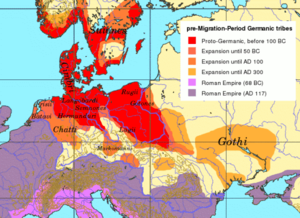It is estimated that around 4000BC there were just 3000 people in Britain, slowly rising to around 500,000 by 50BC. Clearly this is not just a case of procreation but natural immigration following game animals. Migration therefore has been a focus of our population from very early times but not one that can be recorded except in the DNA of individuals to show which migration pattern their ancestors followed.
DNA profiling can therefore can be of use to the family historian in determining in which wave of migration their ancestors arrived in Britain and also whether there is a relationship between individuals that have the same name and yet no documented relationship can be determined.
The next people to occupy Britain were the Celts who developed their own language around 1000BC. There is little evidence of migration during the iron age and by the time of the arrival of the Romans in 43AD, the Celts descending from the Neolithic population were already present in Britain.
The Roman period from 43AD to 410AD saw the arrival of some 20,000 combat troops and a similar number of auxiliaries and camp followers. This period in our history was a disaster for the indigenous population in the south with virtual total destruction of the Celtic societies in the south and subsequent migration westward to Wales and Cornwall. The population in AD200 was thought to be between one and two million.

The end of the Roman occupation saw the arrival of the Anlo-Saxons a term defining a number of Germanic tribes, mainly, the Angles, Saxons and Jutes but also the minority tribes of Franks, Frisians and Suevi. This means that we have an ethnic diversity and cultural elements coming from an area as diverse and as far apart as from the Jutland peninsula to the Lower Rhine. There must have been oral traditions passed down by the various tribes but these appear not to have survived into recorded history.
Frisians were from the Frisian Islands and the area to the north of the Netherlands, and the Franks were from areas along the Rhine and Merovingian Gaul. The Suevi were from Sweden.
The next wave of immigrants brought death, destruction and abject terror amongst the indigenous population. The first Viking raid was recorded in 789 AD and then in 793 AD with an attack at Lindisfarne. The Wessex king, Alfred repulsed the Danes at the end of the 9th Century but the Vikings were too strong to remain defeated and Canute the King of both Norway and Denmark defeated the English in 1016. The Norsemen remained in power for another 50 years when their migration was ended by William at the Battle of Hastings. Their reign in Scotland lasted longer with Magnus Barefoot‘s seizure of the Western Isles between 1098 and 1104.
With William the Conqueror we have the beginnings of recorded history that is of use to the average family historian and so our story of British migration from, to and within the British isles our story can begin.
Related articles



